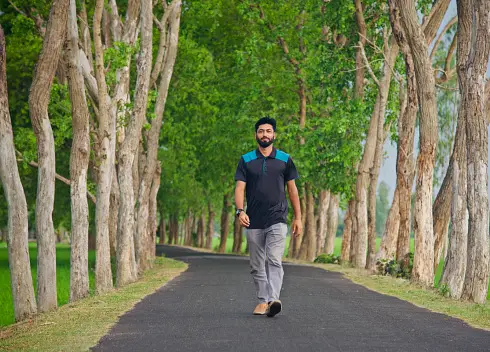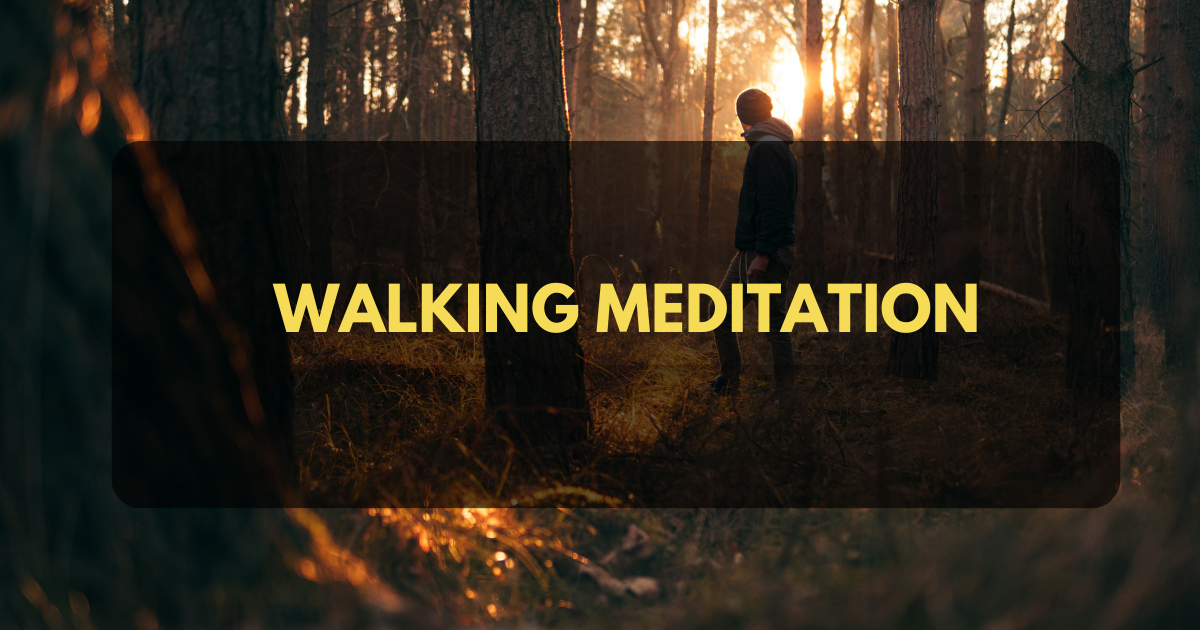Master the Art of Walking Meditation
Imagine finding your peace and calm, not on a mountain peak or in a silent room, but right where your feet touch the ground—the world of “walking meditation” awaits you.
Walk with us on this journey as we explore the power of mindfulness in motion, uncovering how a simple stroll can transform your life.
Let’s dive right in!
What is Walking Meditation?
Picture this: You’re walking in the park, feeling the soft ground beneath your feet and the warm breeze on your skin. But here’s the twist—you’re not lost in thought.
Instead, you’re fully present, focused on your steps and breath. That’s the essence of walking meditation—a practice where you walk mindfully, embracing each moment.
Why Do People Do It?
Life can get pretty crazy, right?
Finding peace can be challenging between work, family, and everything else.
That’s where walking meditation steps in.
It’s like pressing pause on the chaos and finding a moment of calm in your day. It’s not about reaching a destination; it’s about enjoying the journey step by step.
Who Started Walking Meditation?
Now let’s talk about the origins of this practice.
Have you heard of Thich Nhat Hanh?
He’s a wise Buddhist monk and teacher who shared a specific type of walking meditation that’s become pretty popular. It’s like his special recipe for mindfulness.
Thich Nhat Hanh’s walking meditation helps you stay focused on each step, making you feel connected to yourself and the earth beneath your feet.

Why is Thich Nhat Hanh’s Walking Meditation Special?
Ah, the million-dollar question!
This practice reminds us to slow down and be present in a world that’s always in a hurry.
It’s not about rushing from point A to B but savoring every step in between.
This practice isn’t just about taking steps—it’s about grounding yourself in the present moment.
Here’s how it works:
- Anchoring to the Earth: Thich Nhat Hanh’s walking meditation uses each step to anchor the present. It’s like a rope connecting you to the “now” as your feet touch the earth.
- Mindful Movement: You’re fully aware of each movement as you walk. From the lifting of your foot to the placing of it back down, every action is intentional.
- Deepening Connection: This practice deepens your connection with the earth beneath you. You’re not just walking; you’re stepping with gratitude and awareness.
Think of Thich Nhat Hanh’s walking meditation as a way to anchor yourself in the present moment.
It’s like using the act of walking as a gentle reminder to stay focused and centered.
This practice brings you back to our fast-paced lives, where our minds often wander off to a million different places.
Back to the feeling of the earth beneath your feet, the rhythm of your breath, and the simple beauty of taking one step at a time.
It’s not about being a meditation expert—it’s about embracing the practice and letting it infuse your walk with a sense of presence and peace.
How to Meditate While Walking
If you’re wondering how you can meditate while walking in the world, you’re in for a treat. It’s not some mystical art reserved for monks—it’s a down-to-earth practice anyone can master.
So please put on your comfy shoes, and let’s take a step-by-step journey into a walking meditation.
Here is a walking meditation instruction by Tara Brach, and here is a guided walking meditation video by Adam Dacey:
https://www.youtube.com/watch?v=NfPBlRE4RIc
The Science Behind Walking Meditation
Now, you might be thinking, “Okay, this sounds nice, but is there any science behind it?” Absolutely! Walking meditation isn’t just some woo-woo practice—it’s backed by science.
Let’s take a peek at what’s going on in that brain of yours when you meditate while walking:
- Reduced Stress. Stressed out? Walking meditation is here to rescue you. It’s like a mini-vacation for your brain. As you walk mindfully, stress hormones take a step back, making room for relaxation and tranquility.
- Improved Focus. Ever felt like your mind is all over the place? Walking meditation helps you wrangle your wandering thoughts. Focusing on each step and your breath gives your brain a workout in attention and concentration.
- Enhanced Emotional Balance. Moods on a roller coaster? Walking meditation can help stabilize those ups and downs. It’s like a soothing balm for your emotions, allowing you to respond to life’s challenges with greater stability.
- Better Cardiovascular Health. Guess what? Walking meditation isn’t just good for your mind—it’s a heart-healthy practice too. As you walk and breathe mindfully, your heart gets a gentle workout, promoting better circulation and cardiovascular well-being.
- Reduced Anxiety. Anxiety can feel like a storm brewing inside you. The good news? Walking meditation can help calm the storm. Focusing on your steps and breath creates a space where anxiety has less room to take over.
- Boosted Creativity. Feeling stuck in a creative rut? Walking meditation might just be your ticket out. As you let your mind wander during your walk, you’re giving your creative juices a chance to flow.
- Increased Mindfulness. Mindfulness is all about being present. With walking meditation, you’re practicing mindfulness with every step. It’s like giving yourself a crash course in staying connected to the moment.
- Connection with Nature. Picture this: You’re walking in a park, feeling the breeze on your skin, and hearing the rustling leaves. Walking meditation deepens your connection with nature, enriching your stroll.
- Enhanced Self-Awareness. Want to know yourself better? Walking meditation is your guide. As you walk, you become more attuned to your body, thoughts, and emotions—a journey of self-discovery.
- Better Sleep. Dreaming of a good night’s sleep? Walking meditation can help you sleep more soundly. Reducing stress and promoting relaxation sets the stage for restful slumber.

Types of Walking Meditation: Exploring Mindfulness in Motion
Alright, let’s dive into the world of walking meditation and explore its various flavors.
Just like ice cream comes in different tastes, walking meditation isn’t a one-size-fits-all practice.
Let’s unwrap these variations and see which one resonates with you:
Traditional Walking Meditation:
This is the classic version. You can choose a small space and take slow, smaller steps. It’s the perfect type of walking for indoors or outdoors in compact spaces.
Labyrinth Walking:
Labyrinth walking is like a special kind of stroll that works magic on your mind. You’re not racing anywhere but moving thoughtfully on a marked path. It’s like pressing the pause button in a quiet place to find a level of concentration that’s hard to come by in the daily chaos.
Nature Walking Meditation:
This one’s a match made in heaven for nature lovers. As you walk in a natural setting, you connect with the environment. Feel the earth beneath your feet, the rustling leaves, and the whispers of the wind.
How to Integrate Walking Meditation into Your Daily Life
Now that you’ve explored the flavors of walking meditation, how can you actually fit it into your daily routine?
Don’t worry—it’s easier than you might think! Let’s find out how to sprinkle mindfulness into your everyday steps:
- Commute with Awareness: Make your daily commute mindful. Whether walking to the bus stop or your office building, use that time to practice walking meditation.
- Lunchtime Strolls: Instead of gobbling lunch at your desk, take a leisurely walk outside. Feel the sun on your skin, the breeze in your hair, and the ground beneath your feet.
- Walking Breaks: If you’re working from home or in an office, set an alarm for a short walking break. Use it to clear your mind and recharge your energy.
- Mindful Errands: Next time you’re at the grocery store or running errands, try walking mindfully. It can turn a mundane task into a peaceful experience.
Ever taken a lunchtime stroll and felt like a new person afterward?
Imagine walking back to work with a clearer mind, ready to tackle the rest of your day. That’s the power of integrating walking meditation into your routine!

What are the Differences Between Walking Meditation and Sitting Meditation?
Ah, the tale of two meditations—walking and sitting. They’re like cousins from the same family, but each has its distinct differences.
Let’s explore them:
Walking Meditation:
- Involves movement
- Focuses on the sensation of walking and breath
- Great for those who find stillness challenging
- Ideal for integrating mindfulness into daily activities
Sitting Meditation:
- Involves stillness
- Often requires closing your eyes
- Focuses on breath, body sensations, or mantras
- Ideal for deep introspection and prolonged meditation sessions
Now comes a big question: Is walking meditation as effective as sitting meditation?
The Truth About Effectiveness
Let’s get one thing straight: there’s no “one-size-fits-all” answer. Both walking and sitting meditations have their strengths. It’s all about what you need at the moment.
Here’s the deal:
Walking Meditation:
- Energizes your body and mind
- Improves your ability to stay present while on the move
- Offers a gateway to mindfulness in your daily life
Sitting Meditation:
- Deepens your practice through stillness
- Allows for focused introspection and self-discovery
- Can be longer and more immersive
Imagine this scenario: You’re having a hectic day. You can’t find a quiet spot for traditional sitting meditation.
But guess what?
You have your walking shoes with you.
You step outside, embrace walking meditation, and instantly feel calmer.
It’s like your personal sanctuary on the go.
Key Takeaway: Your Choice, Your Practice
Walking meditation and sitting meditation are like tools in your mindfulness toolbox.
They serve different purposes, but both are effective in their own right. You get to choose what suits you best.
So whether you’re walking or sitting, the important thing is that you’re taking time for yourself, finding stillness, and nurturing your inner peace.
Ready to Take a Step Toward Well-Being?
These benefits aren’t just fluffy words—they’re backed by science. Research shows that walking meditation can positively impact your mental and physical health. It’s like giving your whole being a gentle hug.







